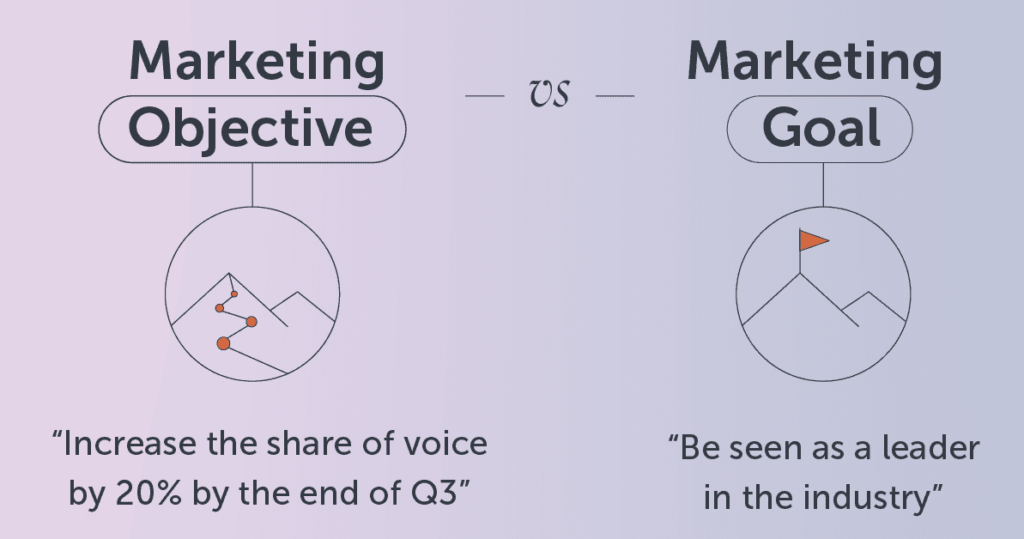Contents
- Marketing Goals: Defined
- Why Setting and Communicating Marketing Goals is Imperative
- Types of Marketing Goals
- How to Set Marketing Goals
- Examples of Marketing Goals
- How Scenario Planning Can Help You Keep Your Goals Agile
- Marketing Goals vs Marketing Objectives
- How to Set Marketing Objectives
- Examples of Marketing Objectives
- How to Measure Your Marketing Goals and Objectives
How to Set Marketing Goals
01/17/2024

Embarking on a successful marketing journey requires a clear roadmap, and that begins with well-defined goals. In this blog post, OptiMine will explore the art and science of setting effective marketing goals. Setting the right objectives is not merely a checkbox exercise; it’s a strategic imperative that aligns marketing efforts with overarching business aspirations. We’ll delve into the fundamental steps to craft marketing goals that will propel your brand forward and lay the foundation for a purposeful and impactful marketing strategy. Let’s get started!
Marketing Goals: Defined
Marketing goals are broad, overarching outcomes that a business aims to achieve through its marketing efforts. They are often aligned with the overall business objectives and provide a high-level direction for the marketing strategy. Marketing goals can encompass a variety of outcomes, such as increasing brand awareness, generating leads, boosting sales, expanding market share, or enhancing customer engagement. The effectiveness of marketing campaigns and initiatives is often evaluated against these predetermined goals, providing a clear benchmark for success and helping businesses focus their resources and efforts to achieve desired outcomes in the competitive marketplace.
Why Setting and Communicating Marketing Goals is Imperative
Marketing goals are critical to any marketing campaign as they serve as the foundation for strategic planning, execution, and evaluation. Here’s why:
Direction and Focus
Marketing goals provide a clear sense of direction for the campaign. They help define what the campaign aims to achieve, whether it’s increasing brand awareness, driving sales, or improving customer retention. This clarity ensures that the marketing team stays focused on the most important objectives.
Measurable Outcomes
Goals should be specific and measurable, allowing the team to track progress and success. This measurement provides valuable insights into the effectiveness of the campaign, enabling adjustments and optimizations in real-time or for future campaigns.
Resource Allocation
Well-defined marketing goals help allocate resources efficiently. Whether it’s budget, time, or manpower, knowing the goals allows marketers to prioritize tasks and allocate resources where they are most needed to achieve the desired outcomes.
Strategy Development
Goals guide the development of marketing strategies and tactics. For instance, if the goal is to increase online sales, the team might focus on digital advertising, website optimization, and e-commerce strategies. Without clear goals, strategies may lack cohesion and effectiveness.
Alignment with Brand Objectives
Only after broader brand goals and objectives have been identified should marketing goals be decided. This ensures that marketing efforts contribute directly to the overall success and growth of the organization. It helps create a unified approach where different departments work in harmony towards common goals.
Adaptability and Optimization
As the campaign progresses, marketers can assess whether they are on track to meet their goals. If not, adjustments can be made in real-time. This adaptability is crucial in the dynamic landscape of marketing, allowing teams to optimize their approach based on real-time data and feedback.
Communication and Accountability
Simply communicating goals once or twice is not enough. Marketing and brand teams need their voices heard when exploring and ultimately deciding on the marketing objectives. Only then, can a clear communication plan be developed, deployed and tracked.
Types of Marketing Goals
Several frameworks can guide the formulation and organization of marketing goals. These frameworks help ensure that goals are well-defined, aligned with business objectives, and measurable. Here are some popular marketing goal frameworks:
SMART Goals

The SMART goal framework (source linked here) is a widely used approach for setting and achieving goals in various fields, including marketing. SMART is an acronym that stands for Specific, Measurable, Achievable, Relevant, and Time-Bound. Here’s a breakdown of each component:
- Specific: Goals should be clear and specific, leaving no room for ambiguity. They answer the questions: What needs to be accomplished? Why is it important? Who is involved? Where will it happen?
- Measurable: Goals should include criteria for measurement to track progress and determine when the goal is achieved. Quantifiable metrics provide a concrete way to evaluate success and identify areas for improvement.
- Achievable: Goals should be realistic and attainable. While they can stretch an individual or team to reach their full potential, they should not be so challenging that they become demotivating or unattainable given available resources.
- Relevant: Goals should be aligned with broader objectives and contribute to the overall success of the organization. They need to be relevant to the mission and purpose of the business, ensuring that efforts are directed toward meaningful outcomes.
- Time-Bound: Goals should have a defined timeframe for completion. This creates a sense of urgency and helps prevent procrastination. Setting deadlines also allows for better planning and prioritization of tasks.
The SMART goal framework is invaluable in marketing as it provides a structured approach to goal-setting, ensuring objectives are specific, measurable, achievable, relevant, and time-bound. This clarity enhances communication, aligns marketing efforts with broader strategies, enables precise measurement of success, and fosters accountability, ultimately promoting effective planning and optimization of marketing campaigns.
Clear Goals

The more agile variant of SMART goals are CLEAR goals (source linked here), which were created after the SMART goals framework to allow room for adaptation (which was not explicitly included in the previous framework). CLEAR is an acronym that stands for Collaborative, Limited, Emotional, Appreciable, and Refinable. Here is a breakdown of each component:
- Collaborative: Your goal should engage and energize your team, making sure to include diverse and varied perspectives.
- Limited: These are short-term goals, often on the road to longer-term achievements. That means that each goal should be limited in its timeline and complexity.
- Emotional: Your goal should feel emotionally important to you and to your team members.
- Appreciable: These goals should be able to be built upon or put into a part of a series. CLEAR goals are smaller goals that develop into larger outcomes.
- Refinable: CLEAR goals are all about flexibility. They should have room – and your team should have the mental headspace – to alter any aspect of the goal as conditions change.
RACE Goals

The RACE framework (Reach, Act, Convert, Engage) provides a systematic approach for brands to set marketing goals by aligning them with specific stages of the customer journey in the digital space (source linked here). Here’s how the RACE framework helps brands set marketing goals:
- Reach: In the “Reach” stage, brands can set goals related to increasing brand awareness and expanding their online presence. This may involve goals such as growing website traffic, increasing social media followers, or improving search engine visibility.
- Act: During the “Act” stage, the focus is on engaging and capturing the interest of the audience. Goals may include increasing engagement metrics (likes, shares, comments), growing the subscriber base, or encouraging visitors to spend more time on the website.
- Convert: The “Convert” stage involves turning engaged audiences into customers. Goals here may include increasing conversion rates, boosting online sales, or generating leads through targeted campaigns. Setting specific metrics for conversion actions is crucial.
- Engage: In the “Engage” stage, the goal is to build long-term relationships with customers. Brands can set goals related to customer retention, increasing customer lifetime value, and fostering brand advocacy. Metrics may include repeat purchase rates and customer satisfaction scores.
By aligning marketing goals with each stage of the RACE framework, brands can create a comprehensive strategy that guides their digital marketing efforts from initial brand awareness to customer loyalty. The framework helps in identifying key performance indicators (KPIs) for each stage, allowing for more effective measurement of success and optimization of marketing strategies based on real-time data and insights. This customer-centric approach ensures that marketing goals are not only aligned with business objectives but also tailored to the evolving needs of the target audience throughout their journey.
How to Set Marketing Goals
Setting effective marketing goals involves a systematic process to ensure clarity, relevance, and measurability. Here are the basic steps to set and execute your marketing goals:
1. Understand Your Business Objectives
Begin by aligning marketing goals with the broader business objectives. Clearly understand what the organization aims to achieve, whether it’s increasing revenue, expanding market share, launching a new product, or improving customer satisfaction.
2. Define Your Target Audience
Identify and understand your target audience. Clearly define the characteristics of your ideal customers, their preferences, behaviors, and needs. This information will guide the creation of goals that resonate with your audience.
3. Select a Goal Framework
Utilize a marketing goal framework (SMART goals, CLEAR goals, RACE goals, etc.) to help formulate your brand’s goals.
4. Prioritize Goals
Determine the priority of each goal based on its impact on the overall business objectives. Some goals may be short-term and tactical, while others may be more strategic and long-term.
5. Create an Action Plan
Develop a detailed action plan for each goal. Outline the specific strategies, tactics, and activities required to achieve the objectives. Assign responsibilities, allocate resources, and establish timelines for implementation.
6. Set Key Performance Indicators (KPIs)
Identify key metrics and KPIs that will be used to measure progress and success. These indicators should align with the nature of each goal and provide meaningful insights into the effectiveness of your marketing efforts.
7. Monitor and Measure Progress
Implement systems for regular monitoring and measurement of progress. Use analytics tools and other relevant data sources to track the performance of your marketing initiatives against the established KPIs.
8. Adapt and Optimize
Be prepared to adapt your strategies based on ongoing performance assessments. If goals are not being met or if market conditions change, adjust your tactics and strategies accordingly. Continuous optimization is essential for sustained success.
9. Communicate and Align
Ensure that marketing goals are communicated effectively across the organization. Achieve alignment between marketing teams and other departments to foster a collaborative approach to goal achievement.
10. Evaluate and Celebrate Achievements
Conduct a comprehensive evaluation of the outcomes. Celebrate successes, learn from challenges, and use the insights gained to inform future goal-setting processes.
By following these steps, brands can establish a structured and strategic approach to setting marketing goals that are aligned with business objectives and contribute to overall success.
Examples of Marketing Goals
Marketing goals can vary widely based on the specific intentions of a brand. Here are some real-world examples of marketing goals and some strategy ideas on how to achieve each goal:
Brand Awareness

Goal: Increase brand awareness among the target market.
Marketing strategy ideas to achieve goal: Launch a social media campaign, invest in online advertising, sponsor relevant events and upper funnel channels like OOH.
Lead Generation

Goal: Generate new leads through inbound marketing efforts.
Marketing strategy ideas to achieve goal: Implement content marketing, optimize landing pages, run targeted email campaigns.
Sales Growth

Goal: Increase monthly sales for a specific product line.
Marketing strategy ideas to achieve goal: Offer limited-time promotions, enhance product positioning, optimize e-commerce website for conversions.
Customer Acquisition

Goal: Acquire new customers.
Marketing strategy ideas to achieve goal: Launch a referral program, run targeted online ads, optimize the website for lead capture.
Customer Retention

Goal: Increase customer retention.
Marketing strategy ideas to achieve goal: Implement or optimize current customer loyalty program, send targeted email campaigns, gather customer feedback for better customer service.
Website Traffic and Engagement

Goal: Boost website traffic and increase average session duration.
Marketing strategy ideas to achieve goal: Optimize SEO, run a content marketing campaign, enhance the user experience on the website.
Social Media Engagement

Goal: Increase engagement on social media platforms.
Marketing strategy ideas to achieve goal: Increase interactive content published, run social media contests, engage with the audience through comments and messages.
Search Engine Optimization (SEO)

Goal: Improve organic search rankings for key industry-related keywords.
Marketing strategy ideas to achieve goal: Conduct keyword research, optimize on-page content, build high-quality backlinks.
How Scenario Planning Can Help You Keep Your Goals Agile
Scenario planning is a strategic tool that can bolster the agility of marketing goals by enabling organizations to anticipate and adapt to various future scenarios. By exploring multiple potential outcomes and identifying critical variables that could impact marketing objectives, scenario planning fosters a proactive mindset within the marketing team. This approach prompts the creation of flexible strategies that can be adjusted based on changing circumstances, allowing marketers to quickly pivot in response to evolving market conditions. Continuous monitoring of external factors and a commitment to revisiting assumptions enhance the adaptability of marketing goals, ensuring they remain aligned with the dynamic business landscape. Scenario planning not only helps in risk management by identifying potential challenges but also cultivates a culture of adaptability, preventing complacency and promoting a more agile response to the uncertainties of the marketplace.
For more detailed information on scenario planning, read OptiMine’s “Guide to Scenario Planning” blog post.
Marketing Goals vs Marketing Objectives
Marketing goals and marketing objectives are related concepts, but they serve different purposes and exist at different levels of specificity within a marketing plan.
Marketing Goals:
- Definition: Marketing goals are broad, overarching outcomes that a business aims to achieve through its marketing efforts. They are often aligned with the overall business objectives and provide a high-level direction for the marketing strategy.
- Scope: Goals are more general and may lack specific, quantifiable metrics. They define the overall purpose of the marketing activities, such as increasing brand awareness, expanding market share, or boosting sales.
Marketing Objectives:
- Definition: Marketing objectives are specific, measurable, and time-bound targets set to support the achievement of marketing goals. Objectives are more detailed and actionable than goals, providing a clear roadmap for implementing the marketing strategy.
- Scope: Objectives are concrete and quantifiable, often including specific metrics and deadlines. They break down the broader marketing goals into smaller, manageable components.

In essence, marketing goals provide the overarching vision and purpose, while marketing objectives are the specific, measurable steps taken to reach that vision. Goals set the direction, and objectives define the actionable steps to move in that direction. Both are essential components of a comprehensive marketing plan, with goals offering strategic guidance and objectives providing a roadmap for implementation and measurement.
How to Set Marketing Objectives
Setting effective marketing objectives involves a systematic process that aligns with overall brand goals and provides a clear roadmap for marketing strategies. Here are the basic steps to set effective marketing objectives:
1. Align with Brand Goals
Ensure that marketing objectives are directly aligned with the broader business goals and objectives. Understanding the overall mission and vision of the organization is crucial for setting relevant marketing objectives.
2. Be Specific and Clear
Clearly define each marketing objective in specific terms. Avoid vague statements and ensure that the objective is well-defined, leaving no room for ambiguity. This clarity helps in better understanding and execution.
3. Make Objectives Measurable
Include specific metrics and key performance indicators (KPIs) in each objective. Measurable objectives enable effective tracking of progress and provide a basis for evaluation.
4. Set Achievable Targets
Ensure that marketing objectives are realistic and attainable within the given resources and constraints. Setting overly ambitious targets may lead to frustration and decreased morale among the marketing team.
5. Relevance to the Target Audience
Consider the needs and preferences of the target audience when setting marketing objectives. Objectives should be relevant to the target market, ensuring that marketing efforts resonate with and meet the expectations of customers.
6. Establish a Timeframe
Establish a timeframe for achieving each objective. This time-bound aspect creates a sense of urgency and provides a clear deadline for assessment. It helps in better planning and prioritization of tasks.
7. Prioritize Objectives
Prioritize marketing objectives based on their importance and impact on overall business success. Identify which objectives are critical for achieving the broader marketing and business goals.
8. Consider External Factors
Take into account external factors such as market trends, competition, and economic conditions when setting marketing objectives. Being aware of these factors helps in setting objectives that are adaptable to the business environment.
9. Communicate Objectives Clearly
Ensure that marketing objectives are communicated clearly across the organization. This promotes alignment and a shared understanding of the goals, fostering a collaborative effort to achieve them.
10. Regularly Renew and Adjust
Regularly review the progress of marketing objectives and be prepared to adjust them if necessary. Market conditions and business priorities may change, requiring flexibility in the pursuit of marketing goals.
By following these steps, brands can set effective marketing objectives that contribute directly to the achievement of broader business goals.
Examples of Marketing Objectives
Here are some examples of real-world marketing objectives across different business scenarios (similar to marketing goals, but more specific/quantifiable) along with what metrics you can use to measure the progress of each objective:
Brand Awareness
Objective: Increase brand awareness among the target audience by 25% within the next six months.
Metrics: Measure brand recall through surveys, track website and social media engagement, and monitor mentions in the media.
Lead Generation
Objective: Generate 500 new leads per month through digital marketing channels.
Metrics: Track the number of sign-ups, downloads, and inquiries through the website and landing pages.
Sales Growth
Objective: Achieve a 15% increase in product sales within the next quarter.
Metrics: Monitor monthly sales figures, average transaction values, and conversion rates.
Customer Retention
Objective: Improve customer retention rates by 20% over the next year.
Metrics: Track customer churn rates, measure repeat purchase behavior, and gather customer satisfaction feedback.
Website Traffic and Engagement
Objective: Increase website traffic by 30% and improve average session duration by 15% in the next quarter.
Metrics: Use analytics tools to monitor website traffic, page views, and user engagement metrics.
How to Measure Your Marketing Goals and Objectives
The right measurement tool(s) are absolutely essential for gaining insights into the achievement of marketing goals, providing quantifiable data and analytics that illuminate the impact of various strategies and offering a comprehensive view of the performance of marketing activities. They allow for real-time monitoring, enabling agile adjustments to strategies, and facilitate the identification of areas for improvement. Ultimately, these tools not only validate the success of marketing efforts but also empower marketers to continuously optimize and refine their strategies for ongoing success in a dynamic and competitive market.
Not all marketing measurement tools are created equally though. Measurement solutions that use any sort of consumer identity tracking, PII, etc. are not privacy-safe and will put your brand at regulatory risk. Luckily, OptiMine is a 100% future-proof marketing measurement solution that provides the fastest, most actionable cross-channel measurement for all digital and traditional marketing across any online and offline conversion points. Contact us today to learn more about how OptiMine can help your brand measure and achieve its marketing goals!

